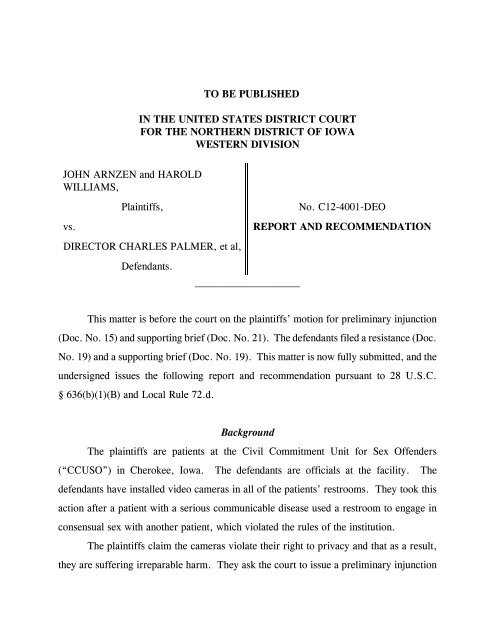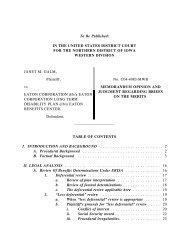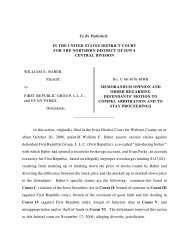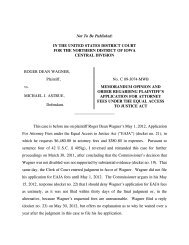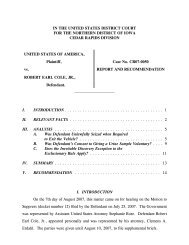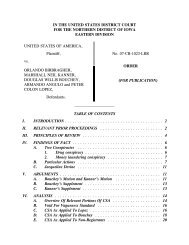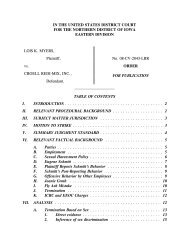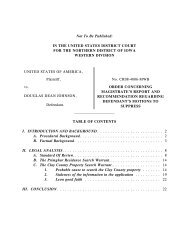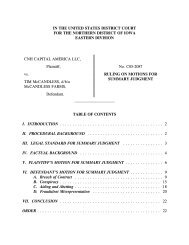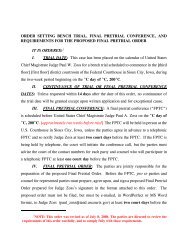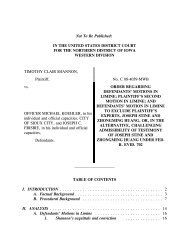Arnzen v. Palmer - Northern District of Iowa
Arnzen v. Palmer - Northern District of Iowa
Arnzen v. Palmer - Northern District of Iowa
You also want an ePaper? Increase the reach of your titles
YUMPU automatically turns print PDFs into web optimized ePapers that Google loves.
TO BE PUBLISHED<br />
IN THE UNITED STATES DISTRICT COURT<br />
FOR THE NORTHERN DISTRICT OF IOWA<br />
WESTERN DIVISION<br />
JOHN ARNZEN and HAROLD<br />
WILLIAMS,<br />
Plaintiffs,<br />
No. C12-4001-DEO<br />
vs.<br />
REPORT AND RECOMMENDATION<br />
DIRECTOR CHARLES PALMER, et al,<br />
Defendants.<br />
____________________<br />
This matter is before the court on the plaintiffs’ motion for preliminary injunction<br />
(Doc. No. 15) and supporting brief (Doc. No. 21). The defendants filed a resistance (Doc.<br />
No. 19) and a supporting brief (Doc. No. 19). This matter is now fully submitted, and the<br />
undersigned issues the following report and recommendation pursuant to 28 U.S.C.<br />
§ 636(b)(1)(B) and Local Rule 72.d.<br />
Background<br />
The plaintiffs are patients at the Civil Commitment Unit for Sex Offenders<br />
(“CCUSO”) in Cherokee, <strong>Iowa</strong>. The defendants are <strong>of</strong>ficials at the facility. The<br />
defendants have installed video cameras in all <strong>of</strong> the patients’ restrooms. They took this<br />
action after a patient with a serious communicable disease used a restroom to engage in<br />
consensual sex with another patient, which violated the rules <strong>of</strong> the institution.<br />
The plaintiffs claim the cameras violate their right to privacy and that as a result,<br />
they are suffering irreparable harm. They ask the court to issue a preliminary injunction
ordering the defendants to point the cameras at the ceiling or, alternatively, to cover the<br />
camera lenses with lens caps. The defendants resist the motion, arguing that the cameras<br />
serve an important institutional purpose because they provide a method for monitoring the<br />
activities <strong>of</strong> patients in bathrooms, where there is “a high likelihood <strong>of</strong> patients acting out<br />
physically and/or sexually.” Doc. No. 20-2, p. 1. The defendants also allege that<br />
procedures have been implemented to govern the use <strong>of</strong> the cameras that protect the<br />
privacy interests <strong>of</strong> the plaintiffs.<br />
Legal Standard<br />
Discussion<br />
“A preliminary injunction is an extraordinary remedy never awarded as <strong>of</strong> right.”<br />
Winter v. Natural Res. Def. Council, Inc., 555 U.S. 7, 24 (2008) (citing Munaf v. Geren,<br />
553 U.S. 674, 689-90 (2008)).<br />
In each case, courts “must balance the competing claims <strong>of</strong> injury and must<br />
consider the effect on each party <strong>of</strong> the granting or withholding <strong>of</strong> the<br />
requested relief.” Amoco Production Co.[v. Gambell], 480 U.S. [531,] 542,<br />
107 S. Ct. 1396, 94 L.Ed.2d 542 [(1987)]. “In exercising their sound<br />
discretion, courts <strong>of</strong> equity should pay particular regard for the public<br />
consequences in employing the extraordinary remedy <strong>of</strong> injunction.”<br />
[Weinberger v.] Romero–Barcelo, 456 U.S. [305,] 312, 102 S. Ct. 1798,<br />
1803 [(1982)]; see also Railroad Comm’n <strong>of</strong> Tex. v. Pullman Co., 312 U.S.<br />
496, 500, 61 S. Ct. 643, 85 L.Ed. 971 (1941).<br />
Id. The Eighth Circuit Court <strong>of</strong> Appeals has since explained:<br />
When evaluating whether to issue a preliminary injunction, a district<br />
court should consider four factors: (1) the threat <strong>of</strong> irreparable harm to the<br />
movant; (2) the state <strong>of</strong> the balance between this harm and the injury that<br />
granting the injunction will inflict on other parties; (3) the probability that<br />
the movant will succeed on the merits; and (4) the public interest.<br />
Dataphase Sys., Inc. v. C L Sys., Inc., 640 F.2d 109, 114 (8th Cir. 1981)<br />
2
(en banc). A preliminary injunction is an extraordinary remedy and the<br />
burden <strong>of</strong> establishing the propriety <strong>of</strong> an injunction is on the movant. We<br />
review the denial <strong>of</strong> a preliminary injunction for abuse <strong>of</strong> discretion. An<br />
abuse <strong>of</strong> discretion may occur when the district court rests its decision on<br />
clearly erroneous factual findings or erroneous legal conclusions.<br />
Roudachevski v. All-American Care Ctrs., Inc., 648 F.3d 701, 705-06 (8th Cir. 2011)<br />
(some citations omitted).<br />
The “Dataphase factors” are consistent with the factors relevant to success on a<br />
motion for preliminary injunction articulated by the Supreme Court in Winter. See Sierra<br />
Club v. U.S. Army Corps <strong>of</strong> Eng’rs, 645 F.3d 978, 989 (8th Cir. 2011). Specifically, “[a]<br />
plaintiff seeking a preliminary injunction must establish [1] that he is likely to succeed on<br />
the merits, [2] that he is likely to suffer irreparable harm in the absence <strong>of</strong> preliminary<br />
relief, [3] that the balance <strong>of</strong> equities tips in his favor, and [4] that an injunction is in the<br />
public interest.” Winter, 555 U.S. at 20. The Court clarified in Winter that where a<br />
defendant’s interests and the public interest outweigh the movant’s interests, as<br />
demonstrated by the movant’s showing <strong>of</strong> irreparable harm, it is unnecessary to consider<br />
whether the plaintiff has established a sufficient likelihood <strong>of</strong> success on the merits. See<br />
id. at 23–24; Sierra Club, 645 F.3d at 992-93.<br />
The court will consider each <strong>of</strong> the pertinent Dataphase/Winter factors in turn,<br />
beginning with “likelihood <strong>of</strong> success on the merits.”<br />
Likelihood <strong>of</strong> Success on the Merits<br />
“Success on the merits has been referred to as the most important <strong>of</strong> the four<br />
factors.” Roudachevski, 648 F.3d at 706. In Winter, the Court noted that, as to the<br />
“likelihood <strong>of</strong> success” factor, “the standard for preliminary injunctive relief requires a<br />
showing <strong>of</strong> a ‘likelihood <strong>of</strong> success on the merits rather than actual success as necessary<br />
3
for permanent relief.” Sierra Club, 645 F.3d at 993 (quoting Winter, 555 U.S. at 32, in<br />
turn quoting Amoco Prod. Co., 480 U.S. at 546 n.12). The Eighth Circuit Court <strong>of</strong><br />
Appeals has noted that this “preferred wording” <strong>of</strong> the standard for success differs<br />
somewhat from the “once familiar” formulation in Dataphase requiring the plaintiff to<br />
show that, “at the very least,” the plaintiff had “established a fair ground for litigation.”<br />
Id. The question is not, however, whether the district court uses the preferred wording,<br />
but whether, in light <strong>of</strong> the evidence, the district court correctly concludes that the plaintiff<br />
is likely to succeed on at least some <strong>of</strong> its claims. Id. at 993-94.<br />
If the plaintiffs were not in any type <strong>of</strong> custody, the monitoring <strong>of</strong> their bathroom<br />
activities obviously would violate their privacy rights. See United States v. Nerber, 222<br />
F.3d 597, 603 (9th Cir. 2000) (“‘[E]very court considering the issue has noted [that] video<br />
surveillance can result in extraordinarily serious intrusions into personal privacy. . . . If<br />
such intrusions are ever permissible, they must be justified by an extraordinary showing<br />
<strong>of</strong> need.’” (alteration in original) (quoting United States v. Koyomejian, 970 F.2d 536, 551<br />
(9th Cir. 1992) (en banc) (Kozinski, J., concurring))). On the other hand, the plaintiffs<br />
would have no right to privacy if they were being confined in a prison rather than in a civil<br />
commitment unit. See United States v. Hogan, 539 F.3d 916, 923 (2008) (“[S]ociety is<br />
not prepared to recognize as legitimate any subjective expectation <strong>of</strong> privacy that a prisoner<br />
might have in his prison cell . . . .” (quoting Hudson v. <strong>Palmer</strong>, 468 U.S. 517, 526, 104<br />
S. Ct. 3194, 3200 (1984))); see also Johnson v. Phelan, 69 F.3d 144, 146 (7th Cir. 1995)<br />
(“[P]rivacy is the thing most surely extinguished by a judgment committing someone to<br />
prison.”). 1 The rights <strong>of</strong> the plaintiffs here fall somewhere between these two situations.<br />
1 “[A] prison inmate has a far lower expectation <strong>of</strong> privacy than do most other individuals in our<br />
society,” G<strong>of</strong>f v. Nix, 83 F.2d 358, 365 (8th Cir. 1986), and retains “very narrow zones <strong>of</strong> privacy.” Hill<br />
v. McKinley, 311 F.3d 899, 905 (8th Cir. 2002). But see Covino v. Patrissi, 967 F.2d 73, 78 (2d Cir.<br />
(continued...)<br />
4
CCUSO is not a prison, and the plaintiffs are not convicted prisoners. They have been<br />
civilly committed to CCUSO because they have been adjudged to be “dangerous persons”<br />
under <strong>Iowa</strong> law. As such, they retain some <strong>of</strong> their liberty interests, although those<br />
interests “are considerably less than those held by members <strong>of</strong> free society.”<br />
Senty-Haugen v. Goodno, 462 F.3d 876, 886 (8th Cir. 2006); see Revels v. Vincenz, 382<br />
F.3d 870, 874 (8th Cir. 2004) (“[a]lthough an involuntarily committed patient <strong>of</strong> a state<br />
hospital is not a prisoner per se, his confinement is subject to the same safety and security<br />
concerns as that <strong>of</strong> a prisoner,” even though the Eighth Amendment does not apply).<br />
In Serna v. Goodno, 567 F.3d 944 (8th Cir. 2009), the Eighth Circuit Court <strong>of</strong><br />
Appeals discussed the rights retained by persons involuntarily committed to a state sex<br />
<strong>of</strong>fender facility:<br />
1 (...continued)<br />
1992) (right to bodily privacy applies “even in the prison context”); see also Boss v. Morgan County, Mo.,<br />
No. 2:08-cv-04195-NKL, 2009 WL 3401715, at *4 (W.D. Mo. Oct. 20, 2009), where the court held as<br />
follows:<br />
Under Eighth Circuit law, “while inmates may lose many freedoms at the prison gate, they<br />
retain at least some <strong>of</strong> their constitutional rights while confined.” Timm v. Gunter, 917<br />
F.2d 1093, 1099 (8th Cir. 1990) (citing Turner v. Safley, 482 U.S. 78, 84, 107 S. Ct.<br />
2254, 96 L.Ed.2d 64 (1987)). The Eighth Circuit has further recognized that inmates have<br />
a right to bodily privacy, which must be weighed against institutional concerns <strong>of</strong> safety<br />
and equal employment opportunities. Id. at 1101 (“Whatever minimal intrusions on an<br />
inmate’s privacy may result from [opposite sex surveillance <strong>of</strong> male inmates by female<br />
guards], whether an inmate is using the bathroom, showering, or sleeping in the nude, are<br />
outweighed by institutional concerns for safety and equal employment opportunities.”); see<br />
also Fortner v. Thomas, 983 F.2d 1024, 1030 (11th Cir. 1993) (recognizing “a prisoner’s<br />
constitutional right to bodily privacy because most people have ‘a special sense <strong>of</strong> privacy<br />
in their genitals, and involuntary exposure <strong>of</strong> them in the presence <strong>of</strong> people <strong>of</strong> the other<br />
sex may be especially demeaning and humiliating’” (quoting Lee v. Downs, 641 F.2d<br />
1117, 1119 (4th Cir. 1981))); Covino v. Patrissi, 967 F.2d 73, 78 (2d Cir. 1992)<br />
(explaining that “we have little doubt that society is prepared to recognize as reasonable<br />
the retention <strong>of</strong> a limited right <strong>of</strong> bodily privacy even in the prison context”).<br />
5
Neither we nor the Supreme Court have determined the<br />
appropriate standard for considering whether a particular<br />
search violates the Fourth Amendment rights <strong>of</strong> a person who<br />
is involuntarily civilly committed. We have, however,<br />
identified the constitutional standard applicable to an alleged<br />
violation <strong>of</strong> the Fourth Amendment rights <strong>of</strong> an involuntarily<br />
committed person based upon a seizure. See Andrews v. Neer,<br />
253 F.3d 1052, 1061 (8th Cir. 2001). The plaintiff in<br />
Andrews, who was lawfully involuntarily committed, brought<br />
a 42 U.S.C. § 1983 suit alleging that a seizure using excessive<br />
force violated his Fourth Amendment rights. Id. at 1055,<br />
1061. In a matter <strong>of</strong> first impression, we determined that such<br />
a Fourth Amendment seizure claim “should be evaluated under<br />
the . . . standard usually applied to excessive-force claims<br />
brought by pretrial detainees.” Id. at 1061.<br />
In making this determination, we considered whether<br />
involuntarily committed persons are more like arrestees,<br />
pretrial detainees, or convicted prisoners. Id. We concluded<br />
that the best analogy is to pretrial detainees because<br />
“confinement in a state institution raise[s] concerns similar to<br />
those raised by the housing <strong>of</strong> pretrial detainees, such as the<br />
legitimate institutional interest in the safety and security <strong>of</strong><br />
guards and other individuals in the facility, order within the<br />
facility, and the efficiency <strong>of</strong> the facility’s operations.” Id.<br />
Other circuits have relied upon Andrews in considering<br />
constitutional claims raised by involuntarily committed<br />
individuals. See, e.g., Hydrick v. Hunter, 500 F.3d 978,<br />
997-98 (9th Cir.2007); Davis v. Rennie, 264 F.3d 86, 102,<br />
108 (1st Cir.2001). But see Aiken v. Nixon, 236 F. Supp. 2d<br />
211, 236 (N.D.N.Y. 2002) (finding civilly committed persons<br />
akin to prison visitors for the purpose <strong>of</strong> considering the<br />
constitutionality <strong>of</strong> visual body-cavity searches), aff’d, 80 Fed.<br />
Appx. 146, 147 (2d Cir. 2003) (unpublished).<br />
The similarity in the grounds for detaining persons<br />
awaiting trial and persons determined to be sexually dangerous<br />
supports application <strong>of</strong> the analogy to pretrial detainees in the<br />
present case. One reason pretrial detainees are kept in custody<br />
6
prior to trial is “because there is cause to believe that they are<br />
dangerous.” Johnson-El v. Schoemehl, 878 F.2d 1043, 1048<br />
(8th Cir. 1989). For example, under the Bail Reform Act <strong>of</strong><br />
1984, individuals charged with federal criminal <strong>of</strong>fenses shall<br />
be detained prior to trial if “no condition or combination <strong>of</strong><br />
conditions will reasonably assure . . . the safety <strong>of</strong> any other<br />
person and the community.” 18 U.S.C. § 3142(e)(1).<br />
Similarly, commitment under Minnesota law as a sexually<br />
dangerous person “requires a finding <strong>of</strong> future<br />
dangerousness.” Hince v. O’Keefe, 632 N.W.2d 577, 581<br />
(Minn. 2001) (quotation omitted). An individual committed as<br />
a sexually dangerous person in Minnesota is, by statutory<br />
definition, “dangerous to the public.” Minn.Stat. § 253B.02,<br />
subdivs. 17, 18(c).<br />
Although decided under the Due Process Clause <strong>of</strong> the<br />
Fourteenth Amendment, another Supreme Court case,<br />
Youngberg v. Romeo, 457 U.S. 307, 102 S. Ct. 2452, 73<br />
L.Ed.2d 28 (1982), further supports application <strong>of</strong> the<br />
pretrial-detainee standard in Serna’s case. There, the Court<br />
considered the constitutionality <strong>of</strong> the conditions <strong>of</strong><br />
confinement for an involuntarily committed, mentally disabled<br />
man. Youngberg, 457 U.S. at 309, 102 S. Ct. 2452. In its<br />
analysis, the Court stated, “Persons who have been<br />
involuntarily committed are entitled to more considerate<br />
treatment and conditions <strong>of</strong> confinement than criminals whose<br />
conditions <strong>of</strong> confinement are designed to punish.” Id. at<br />
321-22, 102 S.Ct. 2452. After determining that the<br />
involuntarily committed, mentally disabled man retained<br />
constitutionally protected liberty interests, the Court<br />
considered whether the infringement upon his liberty interests<br />
violated due process. Id. at 319-23, 102 S.Ct. 2452. The<br />
Court drew an analogy between pretrial detainees and civilly<br />
committed persons as two groups that could be subjected to<br />
liberty restrictions “reasonably related to legitimate<br />
government objectives and not tantamount to punishment.” Id.<br />
at 320-21, 102 S.Ct. 2452.<br />
7
Against this backdrop, we can discern no justification<br />
for treating a Fourth Amendment claim based upon a search<br />
differently than a claim based upon a seizure. Thus, Andrews,<br />
which addresses a seizure claim, articulates the appropriate<br />
standard for considering whether an involuntarily committed<br />
person has been subjected to an unconstitutional search. See<br />
Andrews, 253 F.3d at 1061. Youngberg illustrates the strength<br />
<strong>of</strong> the analogy between civilly committed persons and pretrial<br />
detainees, concluding these groups are similar even outside the<br />
context <strong>of</strong> a Fourth Amendment claim. See Youngberg, 457<br />
U.S. at 321-22, 102 S.Ct. 2452.<br />
Serna, 567 F.3d at 948-49. Applying these principles, the court held:<br />
Id. at 955-56.<br />
[W]hile we hold that the specific facts <strong>of</strong> Serna’s case present<br />
a close question <strong>of</strong> constitutional law, the searches were not<br />
unreasonable. The defendants’ security and treatment<br />
concerns are genuine and serious; the searches, while invasive,<br />
were conducted privately, safely, and pr<strong>of</strong>essionally; and the<br />
facility was reacting to a recurring problem. We view Serna’s<br />
case as an outer limit under the Bell 2 test and, as such, caution<br />
facility administrators to recognize that courts’ deference under<br />
Bell is not without limits.<br />
“The overriding function <strong>of</strong> the Fourth Amendment is to protect personal privacy<br />
and dignity against unwarranted intrusion by the State.” Schmerber v. California, 384<br />
U.S. 757, 767, 86 S. Ct. 1826, 1834, 16 L.Ed.2d 908 (1966). The court finds that the<br />
plaintiffs have greater privacy rights than those granted to convicted prisoners, and that the<br />
defendants’ use <strong>of</strong> video cameras under the circumstances <strong>of</strong> this case infringes on those<br />
rights. Accordingly, the court finds that the plaintiffs have shown that they are likely to<br />
succeed on the merits.<br />
2 Bell v. Wolfish, 441 U.S. 520, 99 S. Ct. 1861, 60 L.Ed.2d 447 (1979).<br />
8
Irreparable Harm to the Plaintiff<br />
“Likelihood <strong>of</strong> success” is “‘meaningless in isolation . . . [and] must be examined<br />
in the context <strong>of</strong> the relative injuries to the parties and the public.’” Roudachevski, 648<br />
F.3d at 706 (quoting Gen. Motors Corp. v. Harry Brown’s L.L.C., 563 F.3d 312, 319 (8th<br />
Cir. 2009)); accord Winter, 555 U.S. at 23-24 (there is no need to reach the “likelihood<br />
<strong>of</strong> success” factor, if the balance <strong>of</strong> interests weighs against the injunction). The court<br />
must still consider and balance the other Dataphase/Winter factors to decide whether to<br />
issue a preliminary injunction. Therefore, the court examines the plaintiff’s allegations <strong>of</strong><br />
“irreparable harm.” See Winter, 555 U.S. at 20; Roudachevski, 648 F.3d at 705 (citing<br />
Dataphase, 640 F.2d at 114).<br />
The movant must show that “he is likely to suffer irreparable harm in the absence<br />
<strong>of</strong> preliminary relief.” Winter, 555 U.S. at 20. In Winter, the Supreme Court clarified<br />
that, even where a plaintiff demonstrates a strong likelihood <strong>of</strong> prevailing on the merits,<br />
the plaintiff must do more than show a “possibility” <strong>of</strong> irreparable harm; rather, the proper<br />
standard “requires plaintiffs seeking preliminary relief to demonstrate that irreparable<br />
injury is likely in the absence <strong>of</strong> an injunction.” Id. at 22 (rejecting as “too lenient” the<br />
“possibility” <strong>of</strong> irreparable harm standard used by the Ninth Circuit Court <strong>of</strong> Appeals and<br />
the district court in the case below). “‘Irreparable harm occurs when a party has no<br />
adequate remedy at law, typically because its injuries cannot be fully compensated through<br />
an award <strong>of</strong> damages.’” Rogers Group, Inc. v. City <strong>of</strong> Fayetteville, Ark., 629 F.3d 784,<br />
789 (8th Cir. 2010) (quoting Gen. Motors Corp., 563 F.3d at 319). “To succeed in<br />
demonstrating a threat <strong>of</strong> irreparable harm, ‘a party must show that the harm is certain and<br />
great and <strong>of</strong> such imminence that there is a clear and present need for equitable relief.’”<br />
Roudachevski, 648 F.3d at 706 (quoting <strong>Iowa</strong> Utils. Bd. v. Fed. Commc’ns Comm’n, 109<br />
F.3d 418, 425 (8th Cir. 1996)).<br />
9
Here, the plaintiffs allege that the video monitoring <strong>of</strong> their bathroom activities<br />
causes them to suffer humiliation and embarrassment, and interferes with their treatment.<br />
The plaintiffs have made an adequate showing <strong>of</strong> irreparable harm.<br />
Balance <strong>of</strong> Equities<br />
The next Dataphase/Winter factor is whether the balance <strong>of</strong> equities tips in favor<br />
<strong>of</strong> preliminary injunctive relief. Winter, 555 U.S. at 20; Roudachevski, 648 F.3d at<br />
705-06 (stating the Dataphase factor as “the state <strong>of</strong> the balance between [the movant’s<br />
irreparable] harm and the injury that granting the injunction will inflict on other parties”<br />
(citing Dataphase, 640 F.2d at 114)). “In each case, courts ‘must balance the competing<br />
claims <strong>of</strong> injury and must consider the effect on each party <strong>of</strong> the granting or withholding<br />
<strong>of</strong> the requested relief.’” Winter, 555 U.S. at 24 (quoting Amoco Prod. Co., 480 U.S. at<br />
542).<br />
Balancing the harm to the plaintiffs from the loss <strong>of</strong> privacy with the interests <strong>of</strong><br />
CCUSO in monitoring the activities in patient bathrooms, the court finds that the balance<br />
<strong>of</strong> equities tips in favor <strong>of</strong> preliminary injunctive relief. See Youngberg v. Romeo, 457<br />
U.S. 307, 321-22 (1982) (considering proper balance between legitimate state interests and<br />
rights <strong>of</strong> involuntarily committed to reasonable conditions <strong>of</strong> safety and freedom from<br />
unreasonable restraints). This is particularly true in light <strong>of</strong> the specific injunctive relief<br />
recommended by the court in this order.<br />
The Public Interest<br />
The last Dataphase/Winter factor requires the court to consider whether an<br />
injunction is in the public interest. Winter, 555 U.S. at 20; Roudachevski, 648 F.3d at<br />
705–06. The court must consider both what public interests might be injured and what<br />
10
public interests might be served by granting or denying a preliminary injunction. See<br />
Sierra Club, 645 F.3d at 997-98. “[T]he determination <strong>of</strong> where the public interest lies<br />
is also dependent on the determination <strong>of</strong> likelihood <strong>of</strong> success on the merits,” because it<br />
is in the public interest to protect rights. Phelps-Roper v. Nixon, 545 F.3d 685, 690 (8th<br />
Cir. 2008) (First Amendment rights case).<br />
The public interest in ensuring that patients not act out physically and/or sexually<br />
weighs against preliminary injunctive relief in this case. See also Romeo, 457 U.S. at<br />
322-23 (“[C]ourts must show deference to the judgment exercised by a qualified<br />
pr<strong>of</strong>essional. By so limiting judicial review <strong>of</strong> challenges to conditions in state institutions,<br />
interference by the federal judiciary with the internal operations <strong>of</strong> these institutions should<br />
be minimized. Moreover, there certainly is no reason to think judges or juries are better<br />
qualified than appropriate pr<strong>of</strong>essionals in making such decisions.” (footnote omitted)).<br />
However, the court finds that in light <strong>of</strong> the specific injunctive relief recommended in this<br />
order, the public interest will be adequately protected.<br />
In sum, the Dataphase/Winter factors outlined above weigh in favor <strong>of</strong> issuing a<br />
preliminary injunction in this case. The remaining question is the nature <strong>of</strong> the relief<br />
appropriate under these circumstances.<br />
“‘The primary function <strong>of</strong> a preliminary injunction is to preserve the status quo<br />
until, upon final hearing, a court may grant full effective relief.’” Sanborn Mfg. Co. v.<br />
Campbell Hausfeld/Scott Fetzer Co., 997 F.2d 484, 490 (8th Cir. 1993) (quoting<br />
Rathmann Grp. v. Tanenbaum, 889 F.2d 787, 789-90 (8th Cir. 1989), in turn quoting<br />
Ferry–Morse Seed Co. v. Food Corn, Inc., 729 F.2d 589, 593 (8th Cir. 1984)). The court<br />
in Sanborn observed that “[r]equiring [the defendant] to take affirmative action . . . before<br />
the issue has been decided on the merits goes beyond the purpose <strong>of</strong> a preliminary<br />
injunction.” Id. The court explained that, where a movant seeks on its motion for<br />
11
preliminary injunction substantially the same relief it would obtain after a trial on the<br />
merits, the movant’s burden is particularly “heavy.” Id. (citing Dakota Indus., Inc. v.<br />
Ever Best Ltd., 944 F.2d 438, 440 (8th Cir. 1991)).<br />
CCUSO is appropriately concerned about activities <strong>of</strong> patients in the bathrooms at<br />
the facility, but to its credit, in its policy it has attempted to protect, at least to a certain<br />
extent, the privacy rights <strong>of</strong> its patients. The court believes it can fashion relief that will<br />
address the defendants’ concerns while, at the same time, protect the plaintiffs’ interests<br />
while the case is processed.<br />
The court recommends that the plaintiffs’ motion for preliminary injunction be<br />
granted, and that the defendants be enjoined as follows:<br />
During the pendency <strong>of</strong> this action, video cameras may be maintained and<br />
operated in the restrooms and showers <strong>of</strong> the facility, but no one is permitted<br />
to monitor or view the video or any recordings <strong>of</strong> the video without first<br />
obtaining an order from this court authorizing such viewing. The court will<br />
authorize such viewing if the requesting party establishes that there is a<br />
reasonable suspicion that evidence <strong>of</strong> criminal behavior, sexual contact,<br />
and/or acts jeopardizing the secure and safe operation <strong>of</strong> the facility will be<br />
found on the video or on a recording <strong>of</strong> the video. Any motion requesting<br />
authorization to view a video or a recording <strong>of</strong> a video may be filed ex parte<br />
and under seal.<br />
Recommendation<br />
For the reasons stated above, IT IS RESPECTFULLY RECOMMENDED that the<br />
plaintiff’s application for a preliminary injunction (Doc. No. 15) be granted consistent<br />
with the above ruling. 3<br />
3 This order also terminates Docket Number 24, a pro se motion for temporary restraining order,<br />
which is denied.<br />
12
Objections to the Report and Recommendation in accordance with 28 U.S.C.<br />
§ 636(b)(1) and Fed. R. Civ. P. 72(b) must be filed within fourteen days <strong>of</strong> the service <strong>of</strong><br />
a copy <strong>of</strong> this Report and Recommendation. Objections must specify the parts <strong>of</strong> the<br />
Report and Recommendation to which objections are made, as well as the parts <strong>of</strong> the<br />
record forming the basis for the objections. See Fed. R. Civ. P. 72. Failure to object to<br />
the Report and Recommendation waives the right to de novo review by the district court<br />
<strong>of</strong> any portion <strong>of</strong> the Report and Recommendation as well as the right to appeal from the<br />
findings <strong>of</strong> fact contained therein. United States v. Wise, 588 F.3d 531, 537 n.5 (8th Cir.<br />
2009).<br />
IT IS SO ORDERED.<br />
DATED this 12th day <strong>of</strong> April, 2012.<br />
PAUL A. ZOSS<br />
CHIEF MAGISTRATE JUDGE<br />
UNITED STATES DISTRICT COURT<br />
13


